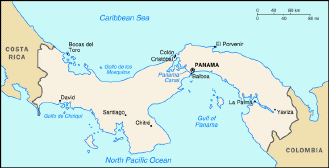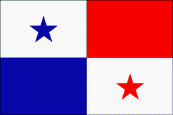



Introduction Panama has a population of 2.4 Million people and is one of the smallest countries in Central America. It’s ethnic composition is 70 percent mestizo (a mix of Indian and European), 14 percent West Indian, 10 percent European, and 6 percent Amerindian. Panama is a multiparty republic, with a president, two vice-presidents, a cabinet, a unicameral legislative assembly serving 5 year terms, and a supreme court. The president is the head of state and the head of the government. The official language is Spanish. Because of the extensive U.S. influence, most Panamanians are bilingual in Spanish and English. The majority of the people (94 percent) are Roman Catholic, although Panama has no official religion. There are also small numbers of Protestants, Muslims, Hindus, and others. |
||
|
||
| Fun Fact Columbus
reached Panama in 1502 on his fourth and final voyage to the New World.
The country was
first explored by Balboa in 1513. The Panama Canal was completed in
1914 and is under control of the U.S. . It is due to return to Panamanian
control on 31 December
1999. |
||
|
||
Geert
Hofstede Dimensions
|
||
|
||
The Geert Hofstede analysis for Panama is similar to it’s Latin American neighbors. There is a high power distance indicating that inequalities of power and wealth have been allowed to grow within the society. Uncertainty avoidance ranks high which indicates a high concern for rules, regulations, controls and issues with career security – typically, a society that does not readily accept change and is risk adverse. Individualism ranks lowest which signifies a society of a more collectivist nature and strong relationships where everyone takes responsibility for fellow members of their group. More Details |
||
Appearance
|
||
|
Behavior
|
||
|
Communications
|
||
Panama Resources International Business Center Newsletter free subscription International Career Center - Information on international careers and jobs |
||
Countries
|
||
Africa Argentina Australia Brazil Canada Chile China Colombia Costa Rica Ecuador Egypt El Salvador France Germany Great Britain Guatemala Hong Kong India Indonesia Italy Japan Mexico New Zealand Panama Russia Saudi Arabia Spain Taiwan United Arab Emirates United States Venezuela |
||
Regions
|
||
Resources |
||
Thanks
to the Global MBA graduates that work diligently on collecting the
information on this site
University of Texas at Dallas - M.B.A. International Management Studies |
||
Page authored by: Joni Nicol |
||
|
||
© 2003
international-business-center.com - all rights reserved
|
||